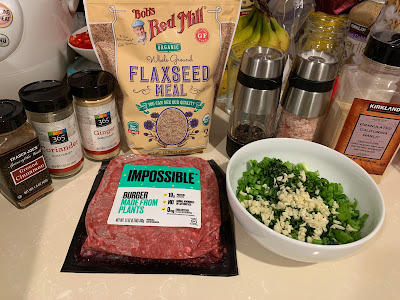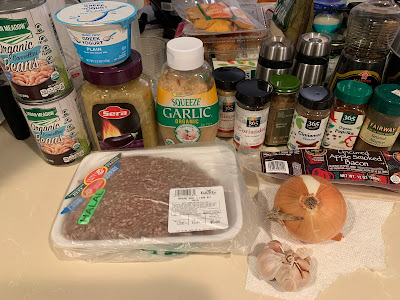I don't remember how I got there, but in looking at Afghan recipes, I ended up on
one for naan on My Ginger Garlic Kitchen. I had already made
naan during our Afghan food exploration, but since it didn't come out that similar to the one we liked at our favorite Ariana, and the one on this site looked much closer, I figured, why not give it another try? At the time, we had one last meal scheduled for the Afghan part of the challenge (the kabuli pulao in the next post), so I decided to make the naan to accompany it.
The ingredients for this bread were very similar to the last one, just in different amounts:
- 3 cups + 1 tbsp flour
- 1 tsp salt
- 2.25 tsp yeast
- 1 tsp sugar
- 2 tbsp olive oil
- about 1 tbsp butter
- 1 cup + a few tbsp warm water
I had intended to do a cost comparison of the two, but over two years later, that's not going to happen, because I have no idea where my old pricing list is and I can't look up any current prices with all the inflation that has happened since then.
I followed the recipe fairly closely to make the naan, and the steps were:
1. In a small bowl, combine 1 cup of warm water, yeast, and sugar. Let it sit for about 10 minutes. (It should look foamy.)
2. In a large bowl, combine 3 cups of flour, salt, and olive oil. Mix well.
3. Add the yeast mixture to the flour mixture, and mix well.
4. Knead for about 5 minutes until one big dough ball that's not too sticky.
5. Cover bowl with plastic wrap, and let sit for about 2 hours for the dough to double in size (or close to it).
6. Gently punch down the dough after the proofing time.
7. Preheat oven to 400 degrees while rolling out the dough.
8. Divide dough into two balls. [See below about a possible step before this one.]
9. Create a mixture with the remaining flour and water, and apply it to your hands.
10. Using your hands, flatten out the dough balls into ovals about 1/4 inch thick. Use a fork to make patterns and lines.
11. Bake until browned, about 10 minutes. Melt butter while baking.
12. Brush with butter, cut into pieces, and place on a plate under a foil tent to keep warm and soft.
The results of this naan experiment were puzzling. The first ball rolled out so much better, but then didn't rise. The second ball had holes everywhere when I tried to roll it out, so I ended up rolling it back up into a ball, kneading it a little more, and then trying again. I couldn't get it as thin as the recipe suggested, but sort of gave up, but that one turned out better and actually rose.
When I went back to the recipe page and watched the demonstration video (which I probably should have done before I made it), I noticed that nowhere in the instructions did it say to knead the dough again between punching it down, dividing it, and rolling it into a ball, but in the video, there was another kneading step. I ended up kneading the second ball again because of my poor rolling, so was that why it turned out better? I'm not experienced enough at bread baking to know, so if anyone has any ideas on why they turned out differently, I'm all ears (or, I guess, eyes).

From the picture, I really thought this one was going to turn out more like the Afghan bread we were used to getting at restaurants, but it was fairly similar to the other one we made (well, at least the second oval that actually rose was). Both were soft and fluffy, but the other one seemed a little more consistently fluffy and would probably be the one we'd go back to again since it turned out more successfully in our kitchen.






















.JPG)















